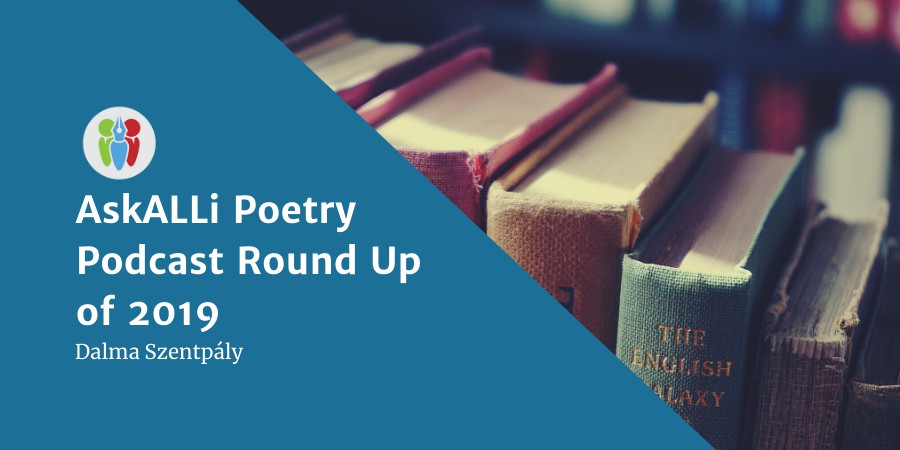Parallel to the growth of self-publishing poetry became one of the fastest growing genres in the late 2010s. So, last year #AskAlli responded to this exciting and heartwarming trend by introducing a new monthly podcast, the Self-Publishing Poetry Salon. Today, Dalma Szentpály, one of the hosts, looks back at 2019 for a poetry podcast round up.
Poetry Podcast Round Up of 2019

Dalma Szentpály
In 2019, ALLi introduced the Self-Publishing Poetry Salon with hosts; author, poet and director of Alliance of Independent Authors Orna Ross and PublishDrive’s self-publishing expert and poetry business advisor Dalma Szentpály.
As this podcast is a unique adventure into this fairly new trend in publishing Orna and I wanted to give all aspiring poets an overview of what publishing your book of poems means in 2019. From producing your first chapbook, through advising you where to sell it, to how you should start promoting it on different social media platforms Self-Publishing Poetry Podcast focused on touching on all the important issues that will get you start planning your poetry book launch in 2020.
Here are 10 tips you can follow in 2020 to bring your words to your poetry-loving audience:
- Chapbooks are an important part of “poetry business”: With publishing poetry you can start small. If you do not yet have enough poems to fill a 80-150 pages long volume you can start by releasing 10-12 poems in a chapbook. Throughout your career as a poet, for events like Christmas, or if you go to festivals and just want to spread the word about you work it is always it is great to have a chapbook of no more than 50 pages up your sleeve.
- Editing poetry can be a vastly different experience than editing prose: Finding a good poetry editor is not an easy job. As a genre poetry is highly focused on word order, form and emotional impact of the structure of the text. So you need to select editors for your work, who you trust to keep the structure of your work intact. You can follow Orna’s method by roping in fellow poets and avid poetry readers into your editing process.
- Use simple fonts and let your words speak for themselves: If you use a highly design-driven font for your poems it might draw attention from the emotional impact of your words. So we would suggest to use the most boring, and usual fronts for your poems. If you want to introduce visual experience to your words add illustrations next to you text that highlight your meaning.
- Make sure to select a cover design for your book that conveys the theme of your poems: Poetry, and every subgenre of poetry, have trending cover styles. Most of the time they are abstract, simple and clean in design. Look into what is trending in the subgenre of your choice and choose a cover for your book that is consistent with your theme.
- Consider distributing to many stores, including reader-subscription platforms: Many “power readers” of poetry (18-35 year old women) read books in digital libraries, or reader subscription platforms like Scribd. They are open to look at new poetry books as part of their subscription much more readily than if you’d only sell it at one store. Distribute as many places and forms as you can to reach these audiences.
- Enter into poetry contest to gain publicity and a solid reader-base: There are hundreds of great poetry contests that are open to anyone who have great skills with their pen. If you win you’ll not only have some money to invest into your book release but you can include the prize in your author bio.
- Imagine your ideal reader as part of your marketing process: Who will read your poetry? The answer will determine how you will communicate about your book of poems and about yourself as a poet. Make sure to write the description to your book of poems, your author bio, your keywords, select the sub-categories of your book based on your ideal reader. This way you’ll target the audience that will fall in love with your words.
- Find comparable poets to your work: It’s important to know who are popular poets nowadays that write in a similar topic, style or genre to your work. You can use this knowledge to attract readers that like the style of those poets and also to distinguish yourself from them and create your own following.
- Find the best-fitting social media platform: Social media is a great way to gain a loyal reader base for poetry. Many popular, best-selling poets like Rupi Kaur, Amanda Lovelace or Atticus started their careers by posting on Instagram or Tumblr. There are many great social media platforms that you can use to gain the attention of poetry readers: HelloPoetry, Allpoetry, Commaful, Litsy etc. But make sure to be social (engage with readers and other poets as well) and share others’ work as well.
- Have a marketing plan for 2020: Draw up an action plan for your poetry launch and marketing plan for the next year. Set up goals that you want to achieve (I want to sell X number of books by the end of the year) and figure out what you’ll do to achieve this month by month. You can include a blog tour, a price promotion or an offline reading event the only essential part of this action to follow up on your promises and be flexible with your planning if something does not pay off the way you wanted it.
Consider distributing to many stores, including reader-subscription platforms: Many “power readers” of poetry (18-35 year old women) read books in digital libraries, or reader subscription platforms like Scribd. They are open to look at new poetry.
Review of the poetry podcast from 2019 with @dalma_szentpaly #indieauthor #selfpublishing #IARTG #ASMRG #writingcommunity Share on X




hi sarah is here..! well i really enjoy to read this amazing sharing, this is really helpful.. well i write as well my own poetry Goodbye Poems i write short poems, well english is not my Mather langues butt i try to my best poems in english so thank you so much for helpful topic.. 🙂